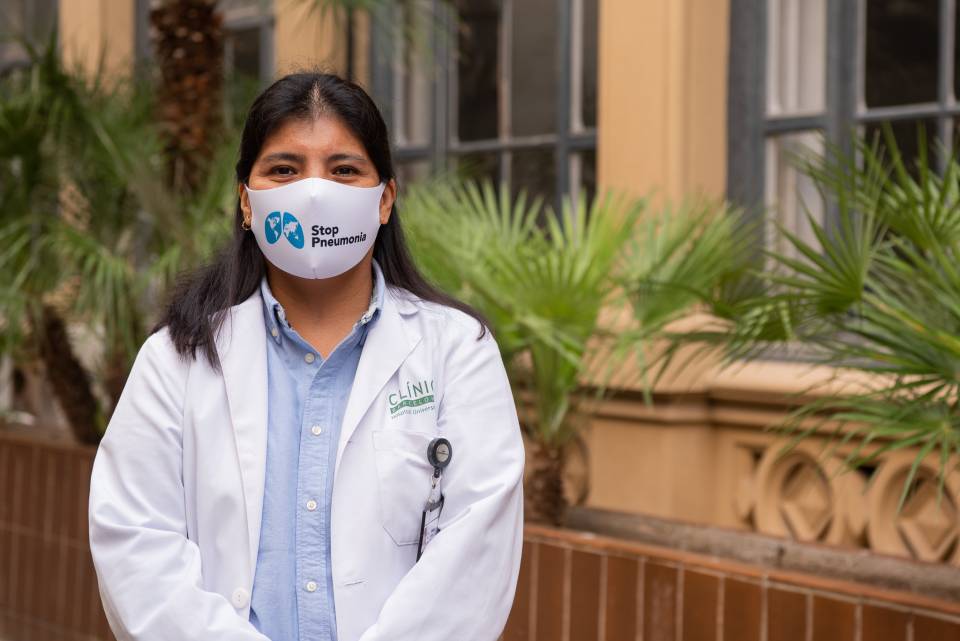For decades, pneumonia has remained the leading cause of death due to infectious disease around the world. Does it affect all countries equally?
Pneumonia is a health problem that affects all countries, however, two-thirds of pneumonia deaths are clustered in a diverse group of 20 low-, middle- and high-income countries, notably India and countries in sub-Saharan Africa. In low-income countries, most pneumonia deaths are among children under five years of age, while in high-income countries adults over 70 years of age have the highest mortality rates.
Globally, only 48% of children are protected with three doses of pneumococcal conjugate vaccine (PCV).
What can be done to reduce mortality?
Innovations that could save hundreds of thousands of lives each year, including new vaccines, low-cost antibiotics, pulse oximeters and oxygen supply, are not reaching those who need them most. For this reason, the Every Breath Counts Coalition was formed to help national governments reduce pneumonia incidence rates and mortality, and to bring together international donors and agencies to give support to the countries that need it most.
Globally, only half of children are protected with three doses of pneumococcal conjugate vaccine (PCV).
What is the latest data on mortality?
In 2019, 2.5 million people died from pneumonia around the world. 600,000 of them were children under 5 years of age.. Three out of ten infant deaths caused by pneumonia occur in the first month of life. Between 2000 and 2012, infant mortality decreased by more than half. Even so, numbers remain very high, especially considering it is a fully treatable and preventable disease.
What are the main risk factors?
The main risk factors include air pollution, a lack of access to water for hand hygiene, and low temperatures. Childhood malnutrition, smoking, exposure to second-hand smoke and low birth weight also have an influence.
What progress has been made in terms of prevention?
There are effective vaccines available to prevent the main causes of pneumonia in children and adults. These include the pneumococcal conjugate vaccine (PCV), the Haemophilus influenzae type b (Hib) vaccine, and the influenza vaccine. Gavi, the Vaccine Alliance has provided financial support for many low-income countries to allow them to introduce vaccines to combat pneumonia, especially in children.
What about diagnosis?
According to UNICEF, only 60% of children under five years with pneumonia symptoms are taken to hospital to receive proper medical care.
The big problem when it comes to diagnosing pneumonia is lack of access to the healthcare system. Often, pneumonia is diagnosed once the disease has already reached a severe stage. In these cases there is hypoxaemia, which means low blood oxygen levels. This is detected using a pulse oximeter. There is no widespread use of this tool. What’s more, it is designed for white-skinned people and cannot detect detect oxygen levels in dark-skinned people, who make up most of the population in the most affected countries.
And no-one has developed a device that works for everyone?
Only one company has updated the pulse oximeter software for all skin types, but it was a consequence of the pandemic, which has brought global health issues that were being neglected to light. One of the initiatives of the global pneumonia awareness-raising campaign, Pneumolight, which I lead, is calling on the relevant agencies to review and standardise pulse oximetry as a tool in aiding pneumonia diagnosis.
Why are cases still being diagnosed in developed countries?
Many people are aware of the vaccines that protect against pneumonia, such as the pneumococcal vaccine, but they don’t know who should get it, when they should get it, and that getting vaccinated against the flu also protects against pneumonia. It is not commonly known that severe pneumonia can have many serious complications, such as heart damage due to pneumococcus (the pathogen that causes the disease) replicating in the heart cells.
Who should get the vaccine, and when?
The pneumococcal vaccine can be given in any month of the year and is recommended for people over 65 years of age, people with chronic diseases, and immunocompromised people. Some of them go to their primary care centre and are given the flu vaccine along with the pneumonia vaccine. Furthermore, the influenza virus can cause pneumonia, especially in people with a weak immune system.
Elderly patients with pneumonia tell me they are afraid of infecting their grandchildren, but it was probably their grandchild who infected them.
What is something interesting that you have seen or experienced in your career?
Something funny that always happens when I interview elderly patients with pneumonia is that they tell me they’re afraid of infecting their grandchildren. But I always explain to them that it was probably their grandchild who infected them. This means that when children have a cold, it is important that they maintain good hand hygiene and wear a mask to minimise the risk of infection when they spend time with older people.
It is a preventable and treatable disease, but there is a lot of passivity.
What motivates you the most about this specialism, and what demotivates you?
I feel very motivated knowing that something can be changed. Little by little, progress is being made. Initiatives such as the global PneumoLight campaign increase visibility of the disease. For example, last year on World Pneumonia Day, which is 12th November, we managed to illuminate 252 monuments in blue in 52 countries across the world in order to raise awareness of the disease.
What demotivates me is seeing how much passivity there is, seeing that there are people with a lot of power who could help, but don’t. People should know that pneumonia not only affects the lungs, but that it is a systemic disease with serious consequences.




